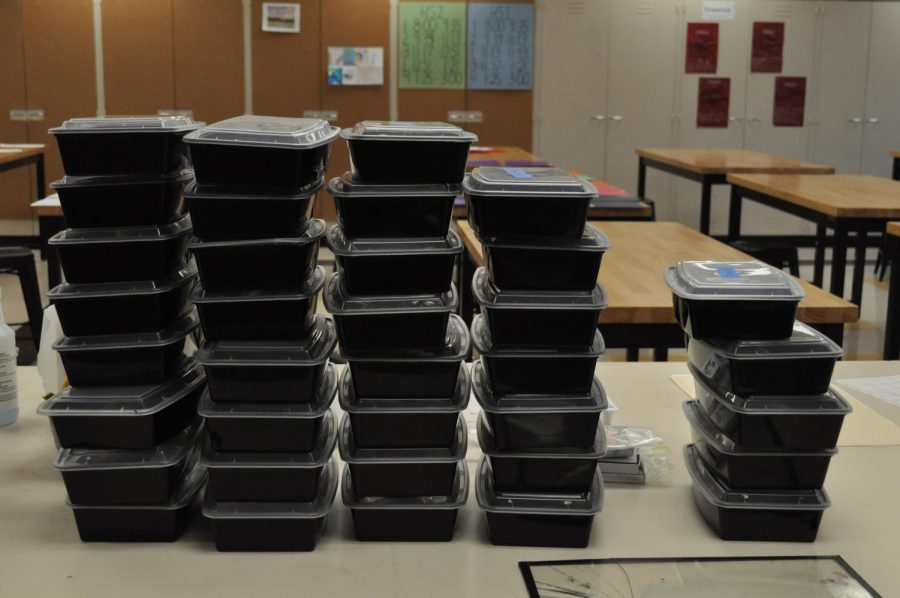Ms. Hernke works tirelessly to prepare materials for students working through a hybrid schedule. The unprecedented situation calls for creative solutions to COVID caused obstacles.
Art adaptations
Despite COVID complications, the CFHS art classes have been putting their best efforts to maintain a strong program.
November 14, 2020
Every year, students in art classes have to put their creative minds to work. For the most part, these talented young artists utilize their creative minds to plan out their projects and put unique spins on them. Although this process of relying on imagination to produce masterpieces is still important today, there is a greater need for being creative when it comes to planning art projects for students on a hybrid school schedule.
Recently the world has been a place of unknowns. With a pandemic at the top of everyone’s mind it is hard to reminisce on the days, where students could simply walk into their art classes, and just work without a need to plan ahead in case of a shutdown; however, Cannon Falls Area High School has been learning how to adapt and role with the punches thrown at them.
Currently, the main high school art classes offered at CFHS are adjusting their past curriculums to fit the unusual circumstances of this year. It in no means has been an easy adjustment, but the art department is taking every day one step at a time.
Drawing and Design
As most could guess, Drawing and Design is a class mainly centered around drawing. So, adjustments in this class have been a little less extreme than those of other art classes. At the beginning of the year, students were given the drawing essentials: paper, drawing pencils, an eraser, and an oversized folder to put all of their stylish sketches in. This is all very similar to materials provided to students in a normal year, the folders just travel to and from student homes with more regularity.
When extra supplies are needed, they are simply dropped off in the school vestibule, as with all other school supplies for distance learners. Or, hybrid students are given the option to take extra supplies home with them at the end of any in-person school week.
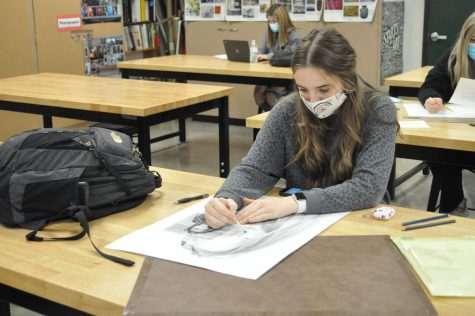
Teagan Strecker, a sophomore at CFHS, is a current Drawing and Design student. She enjoys the class, her favorite part being “When I finish a project, because I’ve put a lot of effort into it, and am proud of it. I don’t consider myself to be particularly artsy, but I usually surprise myself when I put a bit of effort in.”
While Strecker feels that Drawing and Design is enhanced by the hour and a half long periods because students have more time to work, she still feels that it doesn’t compete with all in-school learning. It is easy to get sidetracked, and students don’t have as much of an opportunity to discuss their artwork with other artists.
Art I
Art 1 is a course designed for beginning art students to get a taste of all sorts of different mediums. Throughout the course of the semester, students get the chance to work with pastels, pencils, acrylic paints and clay. Recently, students in Art 1 have been experimenting with monoprints and linoleum prints.
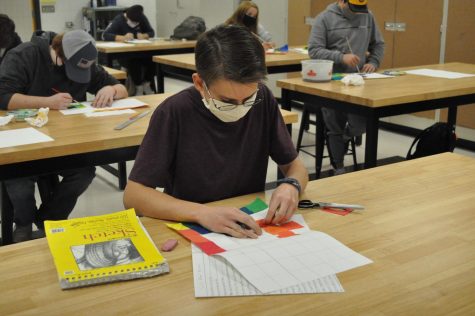
Linoleum prints involve carving a design into a linoleum block, then covering the carved block in ink, and pressing it onto paper, resulting in cool designs that students let dry, before washing the block, and repeating the process in order to create multilayer print designs. As one could predict, this requires an abundance of tools; linoleum blocks, carving tools, rollers to apply ink, the ink itself, and of course paper to complete the process. In adapting to Covid-19, students have been allowed to bring these tools home in small boxes so they can work on their projects in distance learning.
When students are distance learning, they must adapt; however, when students are in school, there are simply a few guidelines to follow. Of course, they are wearing masks and social distancing, which has been made easier thanks to large new tables for the CFHS art room. In regards to these tables, student Kendahl Zimmerman stated that “They give us a lot of space to work with. The only complaint I really have is not being able to sit around a table with my friends while we work.”
Zimmerman enjoys art, but feels that it isn’t as much fun at home. Talking with friends while sketching out designs is a favorite part of visual art classes for many, but unfortunately, distance learners simply don’t get to experience it this year. So, while the Art 1 class has effectively adapted to online learning as far as the actual creation of art goes, the environment and experience while in hybrid learning simply isn’t the same.
Photography
Photography is a class available for students to take their junior or senior year of high school. This class is commonly referred to as a laid-back fun elective by students, and although it has a reputation of being a relaxing course in the past, a bit more stress has been added to it this year as a result of the pandemic.
Mr. Zimmerman, the Photography teacher, explained that his biggest initial challenge with instructing this course through a hybrid schedule was the management of lending out school cameras to use. Obviously, with Covid-19 in mind, the process of sharing and sanitizing school cameras was a huge concern. At first, Mr. Zimmerman was stumped about how to tackle this unique situation. In the past, he simply had his students share cameras, but this was no longer an option. Luckily, he resolved this issue with the help of his students; a great portion of his class offered to use their personal cameras from home, and by allowing students to use their own cameras, the need to check cameras in and out was eliminated.
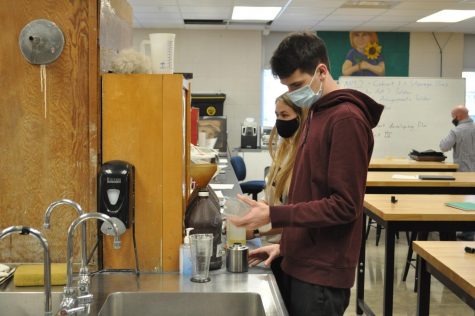
After efficiently solving this dilemma, Mr. Zimmerman moved his attention to figuring out a way for his students to edit their artwork from home. In previous years, students used a program called Adobe Photoshop to edit their photographs. Unfortunately, this program is only found on the MacBooks in the art room. Eventually, after a bit of searching, Mr. Zimmerman was able to find a free program for his students to use on their school issued devices.
Similar to Mr. Zimmerman, many of his students have faced a series of challenges while conforming to the strict hybrid schedule. Belle Freeberg, a senior, stated, “The hardest part of photography this year is not being able to work with someone. Usually, projects are done with two to three people, but this year everything is individual.” Freeberg also added that “It is difficult doing a hybrid schedule with photography because when I am at home, I can’t get my film done, and I am not patient.” This class has been a struggle for some, but everyone is attempting to learn how to look on the bright side.
Independent Art
Independent Art is a class offered specifically to students who want to advance their study of a specific art form. Most of the time this class is only available to students who have taken most, if not all of the other art classes offered at Cannon Falls. Mrs. Hernke, the director of this independent study, has allowed three talented seniors to take on this class this year. In the past, Mrs. Hernke has used the class to help her enthusiastic students dive deeper into a certain style of art. Unfortunately, this year she hasn’t been able to give as many tips because she only sees them half of the time.
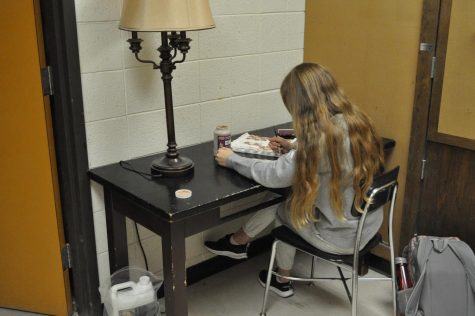
Makayla Bowen, Ashley Langfeldt, and Amelia Qualey are the artistic seniors who have worked hard to be accepted into this class. All three of them have mentioned that the biggest struggle with doing this independent class is staying on task and motivated when at home. These three do not participate in zoom meetings on the weeks they do distance learning, and as a result, they have to keep themselves accountable and on track with their projects.
Self-motivation has posed as a huge challenge for the girls, but they have also faced other issues while adapting to the new learning environment that a pandemic calls for. Bowen mentioned that “The biggest struggle is hauling my materials back and forth every week.” Like Bowen, Qualey has also faced challenges with transporting her projects to and from school. She stated “The projects I work on differ based on my learning environment. When I am at school, I enjoy working on ceramics projects, but since it is such a nuisance to pack up all of my supplies, I choose to create art with the medium ink when at home.”
Staying motivated, transporting projects, and planning for future pieces of artwork has already been a challenge for these talented and dedicated artists. Although they have faced some struggles so far, they are still excited to continue producing masterpieces.
Ceramics
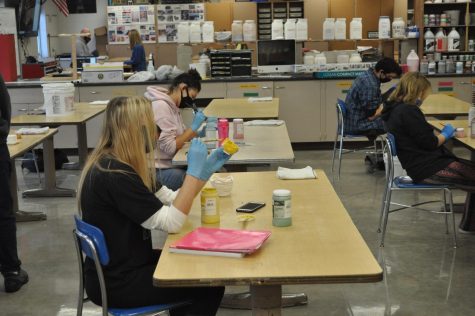
In March, after distance learning was put into effect, ceramics students were forced to abandon typical clay sculptures, instead experimenting with paper vessels. Luckily, this year teachers and students were much more prepared for the challenges of distance learning. Both hybrid and full distance students have been able to get the complete ceramics experience from the comfort of their homes.
The biggest challenge of taking a ceramics class from home is getting students the proper supplies. In order to accomplish this, at the beginning of the year students were all given a bucket. Now, this wasn’t just any bucket. Within, students found all of the ceramics essentials, from sponges and a wooden knife, to a piece of canvas cloth, two sticks, and a PVC pipe to be used as a makeshift slab roller. Students were also given plenty of clay for all of their creations. While the size of projects will have to be limited so that pieces can be transported to and from school, generally, hybrid learning will not be a problem for ceramics students.
In fact, some aspects of hybrid learning will add to the ceramics experience. Students will have more time to work every class period, and many enjoy not having to clean up as often. When students are at home, they also have the option of working on their projects outside of class in addition to in-class time, though it isn’t required.
Despite these adaptations, sophomore Cora Park still wishes that the class was taken all in school, stating that “We aren’t able to do all of the normal things that we would do in a ceramics class,” a sentiment shared by some of her classmates as well.
